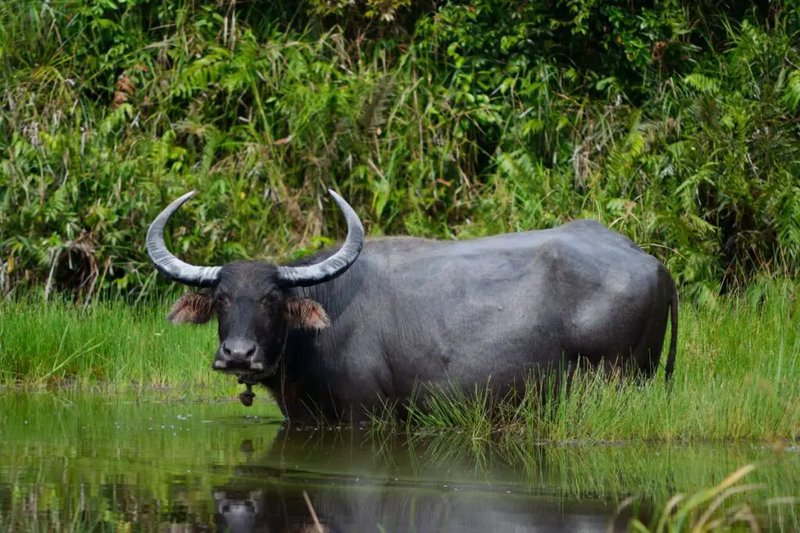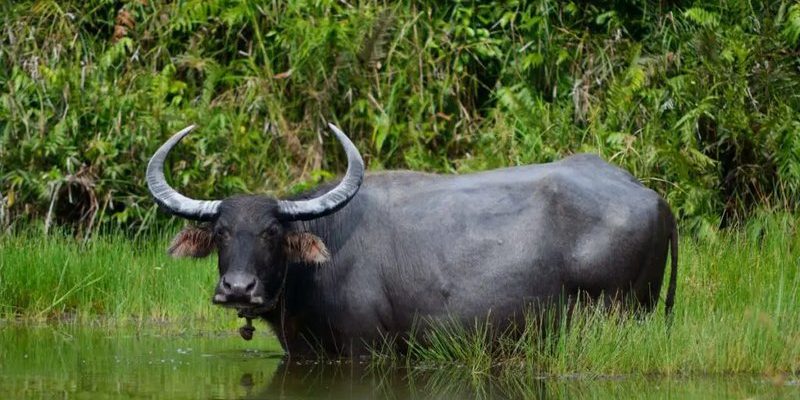
In this article, we’ll dive into some fascinating animals that resemble the water buffalo. We’ll explore their similarities, differences, and some little-known facts about each. So, whether you’re a curious nature lover or just looking to impress your friends with fun facts, keep reading to discover which animals might just be the buffalo’s doppelgangers.
1. Domestic Buffalo
When we talk about animals similar to the water buffalo, we can’t overlook the domestic buffalo itself. While they belong to the same species, it’s interesting to note the differences between wild and domestic varieties. Domestic buffalo are generally a bit smaller than their wild relatives and have fewer aggressive tendencies.
Here’s the thing: domestic buffalo are bred for a variety of purposes, including milk and labor. They often have a more varied diet compared to their wild cousins, who primarily munch on grass and aquatic plants. If you see a herd of buffalo in a field, chances are they’re the domesticated version, which can be identified by their milder temperament and human interactions.
2. Asian Water Buffalo
Next up is the Asian water buffalo, which is practically a twin of the water buffalo, but with some distinct characteristics. Found mostly in South Asia, this breed is crucial for agriculture, especially in rice farming. Asian water buffalo sport large, curved horns and have a stocky build.
You might be wondering how to tell them apart. While both share habitats and lifestyles, Asian water buffalo tend to be slightly darker and have a more pronounced hump on their backs. Their adaptability to various climates is impressive, as they thrive in both wet and dry regions, making them a valuable asset to farmers.
3. Cape Buffalo
Now let’s travel to Africa and meet the Cape buffalo. These are robust animals known for their impressive size and fierce nature. Unlike water buffalo, Cape buffalo are more aggressive, and their horns form a unique shape that resembles a broad curve.
Cape buffalo prefer savannahs and forests over wetlands, making their habitat quite different from that of water buffalo. Interestingly, they often move in large herds, which can provide safety in numbers from predators like lions. If you spot a big, muscular buffalo with a big attitude, chances are it’s a Cape buffalo!
4. Bison
Bison are another close relative worth noting. Native to North America, these large creatures often get confused with buffalo, but they’re actually quite different. For one, bison have a distinctive hump on their shoulders and are covered in shaggy fur, especially in colder climates.
Bison love open plains and grasslands, and unlike water buffalo, they don’t spend much time in water. Interestingly, they are known to form herds that can number in the hundreds, creating quite a sight during their migrations. If you see a massive bull with a hefty appearance and a thick coat, you’re likely looking at a bison, not a buffalo.
5. Yak
If you venture into the Himalayas, you might encounter the yak. These sturdy animals are specially adapted to high altitudes and cold climates. Yaks are covered in long fur, which helps them retain body heat, a feature that sets them apart from water buffalo.
Despite their differences, yaks share a few similarities with water buffalo, like their docility and utility in agriculture. Farmers often use them for transport and as sources of milk and meat. You can easily identify yaks by their long, curved horns and thick fur, making them one of the hardiest animals in the world.
6. Ankole-Watusi
Meet the Ankole-Watusi, an African breed known for its impressive, long horns that can span up to 8 feet! These animals are often referred to as “cattle with style,” standing alongside water buffalo in terms of adaptability and hardiness.
The Ankole-Watusi is primarily a grazing animal and thrives in hot climates. They have a more slender physique compared to the water buffalo, and their horns are a real standout feature. If you see a cattle breed strutting with those impressive horns, you might just be looking at an Ankole-Watusi.
7. Nilgai
The nilgai, or blue bull, is a lesser-known cousin of the buffalo family originating from India. These animals are unique in appearance, with a sleek, blue-gray coat and a more horse-like shape compared to the bulky water buffalo.
Nilgai tend to live in scrub forests and grasslands rather than wetlands, making their habitat quite distinct. While they share grazing habits with water buffalo, you can recognize a nilgai by its slender legs and distinctive coloration. If you spot an animal that looks like a large antelope, it’s likely a nilgai enjoying the sun.
8. Banteng
The banteng is an Asian wild cattle species that closely resembles the water buffalo. Found in Southeast Asia, banteng have a similar build but come in a variety of colors, from dark brown to reddish-brown shades.
They are agile and prefer forest areas where they can find plenty of cover. Unlike water buffalo, banteng are more elusive and less tolerant of human interaction, making them harder to spot in the wild. If you see a sleek, agile bovine in a forest, it could be a banteng!
9. Gaur
Next is the gaur, also known as the Indian bison. These mighty beasts are the largest of all wild cattle and can weigh up to 2,200 pounds! They have a robust physique and can be quite imposing, especially when compared to water buffalo.
Gaur prefer dense forests and hilly areas, making them less common in wet environments. Their thick hides are typically a dark brown or black, and they also have a distinctive hump on their backs. If you encounter a massive, powerful-looking animal, chances are it’s a gaur rather than a water buffalo.
10. Domestic Cattle
Lastly, let’s not forget about domestic cattle—the animals that most people think of when they hear “cattle.” While there are numerous breeds, many have similarities in appearance and behavior to water buffalo.
Most domestic cattle are raised for milk and meat, just like buffalo. However, they generally vary in size and coat color, and they’re often less muscular than water buffalo. If you see a herd of cattle grazing in a pasture, those could easily be mistaken for water buffalo at first glance, particularly if you’re not familiar with the differences.
In conclusion, understanding animals similar to the water buffalo can enhance our appreciation for these magnificent creatures. Each of these animals has its unique traits and adaptations that allow them to thrive in their environments. So, whether you’re planning your next wildlife adventure or just want to impress your friends with your newfound knowledge, you now have a better idea of who the buffalo’s relatives are and how to tell them apart. Happy exploring!

